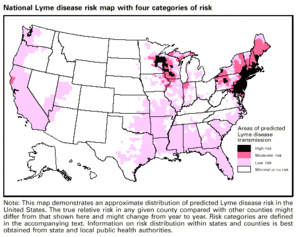Photo Quiz Answer– Q.004 – August 12, 2011
This was an easy one. Don’t let the patient history throw you off. Though he may have been stung by a bee while camping, this problem is unrelated.
The image depicts the typical “bull’s-eye” lesion of erythema migrans, the most typical finding of Lyme disease, present in 80% of cases.
Bee stings do not cause this ring-like pattern. Whether the patient needs a bee sting kit is entirely unrelated to this problem. Anyone who experiences shortness of breath, hives, or other symptoms of anaphylaxis needs a bee sting kit. Even if this were a large local reaction to a bee sting, it would not be considered an allergy and would not require a bee sting kit. One exception would be a person prone to repeat stings, possibly a bee-keeper. My own neighbor died of multiple bee stings, though he was not allergic to bees.
Erythema migrans occurs as a result of infection with the bacterium Borrelia burgdorferi, carried by deer (blacklegged) ticks, pictured above. Patients are frequently unaware of a tick bite and may give no history of exposure. The ticks may be as small as the head of a pin. Other early symptoms include fever, headache, and fatigue. Untreated, the infection may spread to the joints, heart, or nervous system. The infectious is not contagious from human to human.
Treatment begins with prevention. Anyone living in high risk areas (particularly the eastern United States) should be very cautious about walking through high grass or low bushes in wooded areas, particularly in the summer when the deer ticks are most active. Though they normally feed on deer, birds, and mice – the common inhabitants of such a region – they can also feed on humans, horses, cats, and dogs. A tick must actually attach and feed to transmit Lyme disease. Therefore, wearing long pants and long sleeves when in the woods is essential, as is removing any tick as soon as it is noticed, preferably before feeding has occurred. Use insect repellant (containing DEET) and check yourself frequently.
Anyone who demonstrates a typical bulls-eye rash and has had any likelihood of a tick bite should be treated with antibiotics. (Doxycycline for adults and children age 9 and above; amoxicillin or cefuroxime for younger children and pregnant or nursing women. Treat for 10-21 days.)
Prepping summary:
1. Procure long pants and long-sleeved clothing for all family members.
2. Include insect repellant containing 10-30% DEET
3. Learn to recognize the deer tick
5. Include doxycycline and amoxicillin in your prepping supplies.
6. Read more about Lyme disease at: http://www.mayoclinic.com/health/lyme-disease/DS00116





Just a quick tip. DEET is no longer the preferred chemical deterrent for ticks. Permanone spray is much more effective and the effects on clothing can last for a week or more. I spend a good deal of time in the woods hunting, etc and have noticed a significant drop in the number of ticks I find since I started using the spray.
One more thing…there are many medical professionals that believe 21 days is NOT long enough. If you have a bulls-eye or other presenting symptoms (less than 50% get bulls-eye), then get at least 6 weeks of abx. If you have no symptoms but live in Lyme-endemic region, then you may get away with 21 days, but if it were me, I’d ask for 6 weeks anyway. Lyme disease is evil.
Just a few comments re: Lyme disease. There is evidence of transmission of disease in utero, and there is strong suspicion of sexual transmission. The Lyme spirochete mirrors the Syphillis spirochete, so there’s potentially a strong correlation.
Also, tickborne co-infections (Bartonella, Babesia, Erlichia, etc.) are just as common now as Lyme, and in some cases, are more insidious and difficult to treat. Babesia is a parasite like malaria, not a spirochete, so different meds are needed.
Doc in article had it right —- prevention is BEST. Tick checks several times/day when in tick territory, and DAILY if you’re just outdoors for any length of time. Teach your kids.